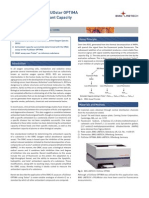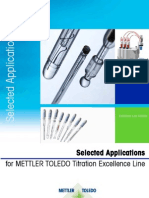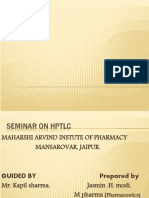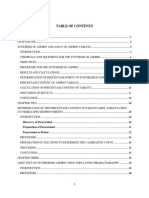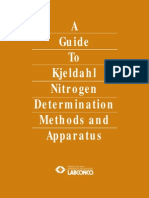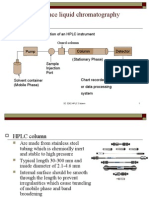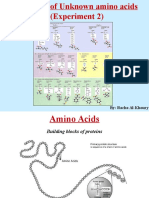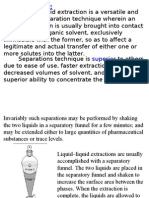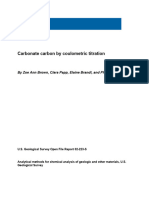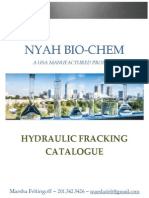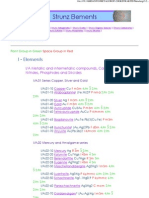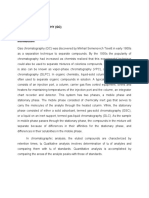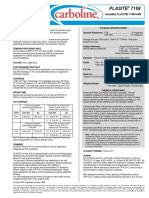10.1.02 AOAC Official Method 985.22 Organochlorine and Organophosphorus Pesticide Residues
10.1.02 AOAC Official Method 985.22 Organochlorine and Organophosphorus Pesticide Residues
Uploaded by
Truong Hoai ThanhCopyright:
Available Formats
10.1.02 AOAC Official Method 985.22 Organochlorine and Organophosphorus Pesticide Residues
10.1.02 AOAC Official Method 985.22 Organochlorine and Organophosphorus Pesticide Residues
Uploaded by
Truong Hoai ThanhOriginal Description:
Original Title
Copyright
Available Formats
Share this document
Did you find this document useful?
Is this content inappropriate?
Copyright:
Available Formats
10.1.02 AOAC Official Method 985.22 Organochlorine and Organophosphorus Pesticide Residues
10.1.02 AOAC Official Method 985.22 Organochlorine and Organophosphorus Pesticide Residues
Uploaded by
Truong Hoai ThanhCopyright:
Available Formats
10.1.
02
AOAC Official Method 985.22
Organochlorine
and Organophosphorus Pesticide Residues
Gas Chromatographic Method
First Action 1985
Final Action 1986
(Applicable to residues of acephate, -BHC, chlorpyrifos, dieldrin,
monocrotophos, and omethoate in lettuce, strawberries, and toma-
toes.)
A. Principle
Nonfatty sample is blended with acetone and filtered; pesticides
are transferred from aqueous filtrate to organic phase by shaking
with petroleum ether and CH
2
Cl
2
; after drying, organic phase is
concentrated in presence of petroleum ether and then acetone to
remove CH
2
Cl
2
; aliquot of concentrated organic phase is injected
into various GC systems for determination of wide variety of pesti-
cide residues.
Absence of cleanup steps permits examination for residues of
many chemical types, including many that would not be recovered
through methods requiring Florisil or charcoal column chroma-
tographic step.
B. Reagents and Apparatus
(Solvents must be purified and final distillation must be conducted
in all-glass apparatus. Caution: See Appendix B, safety notes on
distillation, flammable solvents, acetone, and petroleum ether.)
(a) Solvents.Acetone, CH
2
Cl
2
, petroleum ether, distilled in
glass.
(b) Sodium sulfate.Anhydrous, granular.
(c) Glass wool.Rinse with acetone and alcohol several times
and dry. Washed glass wool will be somewhat brittle.
(d) High-speed blender.Waring Blendor, or equivalent.
(e) Kuderna-Danish concentrator.500 mL with Snyder col-
umn and fitted with volumetric flask or graduated receiving tube.
Calibrate receiving tube with acetone delivered from a buret. Use
buret-corrected volume for sample weight calculation.
(f) Separatory funnels.1 L, with Teflon stopcocks.
(g) Gas chromatograph.(1) For organochlorine residues.
Instrument containing any suitable methyl silicone column, such as
2% OV-101, on 80100 mesh Chromosorb W (HP), 6 ft 2 mm id
glass, and Hall 700A HECD halogen-specific detector. Column,
200; He carrier gas, 60 mL/min; detector 900, H
2
reaction gas
60100 mL/min; n-propanol solvent 0.35 mL/min; electrometer
range 10 in OPR/FLT mode; attenuation 5. (2) For organophospho-
rus residues.(If not available, see Sections E and F.) Instrument
with column containing 2% stabilized DEGS on 80100 mesh
Chromosorb W (HP), 4 ft 2 mm id silanized glass, and P-specific
flame photometric detector (526 nm filter). Column 180; detector
200; He carrier gas, 60 mL/min. Condition column (disconnect
detector) by passing carrier gas through column 0.5 h at 80.
Program temperature at 12/min to 230 and hold overnight. Es-
tablish stable flame at electrometer setting that will produce 50% full
scale deflection for 1.5 ng chlorpyrifos and 6 ng monocrotofos. If
necessary, increase air/O
2
until 50% response. Baseline noise
should be <2%.
(h) Reference standard materials.Acephate, BHC, chlorpyri-
fos, p,p-DDT, dieldrin, methamidophos, monocrotophos, and
omethoate (U.S. Environmental Protection Agency, Pesticides and
Industrial Chemical Respository [MD-8], Research Triangle Park,
NC 27709). Prepare all standards in acetone. Mixed standards.For
Hall system, standard solution should contain at least chlorpyrifos,
dieldrin, and p,p-DDT. For flame photometric detector, standard
solution should contain at least methamidophos and chlorpyrifos.
Do not use mixed standard solutions for quantitation of unknowns.
(i) Standard solutions.Prepare all stock solutions and dilutions
in glass-distilled acetone. Prepare GC standard solutions so 4 L
injection causes 3070% full scale deflection in properly functioning
system. Suggested concentrations are given in Table 985.22. Check
responses before beginning analysis. Store all standard solutions in
tightly stoppered containers in refrigerator. Let equilibrate 1 h at
room temperature before using.
C. Preparation of Sample
Chop or blend fruits and vegetables and mix thoroughly. Weigh
100 g chopped or blended sample into high-speed blender jar, add
200 mL acetone, and blend 2 min at high speed. Do not add Celite.
Filter with suction through 12 cm Bchner funnel fitted with shark-
skin paper. (Note: Rinse filter paper with acetone before filtration of
sample to remove artifacts that can interfere with analysis.) Collect
extract in 500 mL suction flask. Filtration is normally complete in
<1 min. Continuation of vacuum for excessive period can reduce
volume of extract and cause error in calculation.
Place 80 mL sample extract in 1 L separatory funnel, and add 100
mL petroleum ether and 100 mL CH
2
Cl
2
. Shake vigorously 1 min.
Transfer lower aqueous layer to second 1 L separatory funnel. Dry
upper organic layer in first separatory funnel by passing through ca
1
1
2
in. Na
2
SO
4
supported on washed glass wool in 4 in. funnel,
collecting in 500 mL Kuderna-Danish concentrator fitted with volu-
metric flask or calibrated receiving tube. To separate funnel with
aqueous phase, add 7 g NaCl and shake vigorously 30 s until most
NaCl is dissolved. Add 100 mL CH
2
Cl
2
, shake 1 min, and dry lower
organic phase through same Na
2
SO
4
. Extract aqueous phase with
additional 100 mL CH
2
Cl
2
, and dry as above. Rinse Na
2
SO
4
with ca
50 mL CH
2
Cl
2
. Attach Snyder column on Kuderna-Danish concen-
trator (boiling chips may be added) and start evaporation slowly by
placing only receiver tube into steam. After 100150 mL has evapo-
rated, concentrator may be exposed to more steam. When liquid level
in hot concentrator tube is ca 2 mL, add 100 mL petroleum ether
through Snyder column and reconcentrate to ca 2 mL. Add 50 mL
petroleum ether and repeat concentration step. Add 20 mL acetone
and reconcentrate to ca 2 mL. Do not let solution go to dryness during
any concentration step. Adjust volume of extract to suitable definite
volume with acetone.
Calculation of equivalent sample weight.Calculate equivalent
sample weight in final solution as follows:
mg sample equivalent
L final extract
=
100
80
200 + W 10
1
mL final volume
where 200 = mL acetone blended with 100 g sample; W = amount
(mL) H
2
O present in sample; and 10 = adjustment for water-acetone
volume contraction. Thus, when sample contains 85% H
2
O (85
mL/100 g) and final extract volume is 7 mL, each L contains:
1996 AOAC INTERNATIONAL
100
80
200 + 85 10
1
7
=
4.15 mg sample equivalent/ L final extract
D. Determination
Check that both GC systems are working properly by injecting
mixed standard solution into each. Inject ca 12 mg sample equivalent
into each system. Tentatively identify any GC responses on basis of
retention times. Quantitate residue peak(s) by area comparison
withthat obtained from known amount of reference material(s). To
ensure valid measurement of residue amount, area of peaks from
residue and reference standard should be within 25%. Caution:
Repeated injection of sample extracts which have had minimum
cleanup can be detrimental to GC columns. Replace packing material
at front of GC columns as needed to maintain chromatographic
quality and prolong column life.
E. Reagents and Apparatus
(a) Fused silica capillary columns.With bonded methyl sili-
cone and methyl 50% phenyl silicone stationary phases. Column
length: 30 m. Inside diameter: 530 m. Film thickness:
(b) Guard column.Deactivated fused silica tubing, 530 m id,
5.0 m length.
(c) Capillary column connectors.Low or zero dead volume,
suitable for connecting analytical column to retention gap. Various
styles, ferrule, adhesive, and press in types are available from
chromatographic supply companies.
(d) Silanized direct injection adapter.4 mm id.
(e) Column inlet liner.For 4 mm id columns.
(f) Glass wool.Pesticide grade or silanized. Silanized glass
wool free of nitrogen, chlorine, phosphorus, or sulfur contaminates.
F. Instrumetnt Setup
(a) Connecting column and guard column.Cut off column and
retention gap ends with a capillary cleaving tool. Examine cuts with
a 20 magnifier to assure that ends are square and smooth. Clean ends
of column/retention gap with a wiper wetted with methanol. Attach
the retention gap to one end of the column using an appropriate
capillary column connector and secure retention gap to column cage.
(b) Inlet adapter (see Figure 985.22).Rinse adapter with a few
mL of methanol. Attach capillary column/inlet adapter reducing
union to column over end of the adapter, exercising care not to
fracture the end of the adapter when tightening the nut and ferrule.
Place a small, loose plug of glass wool in the inlet end and push to
the bottom of the adapter at the restrictor. Use the minimum amount
necessary to cover top of restrictor. Place column liner for 4 mm id
columns in the open end of the adapter and carefully insert the as-
Table 985.22 Concentrations of Standard Solutions
a
Compound
Instrument Used
B(g)(2)
E
acephate 0.5 0.4
-BHC 0.1 0.1
chlorpyrifos 0.5 0.5
dieldrin 0.2 0.2
p,p-DDT 0.5 0.5
methamidophos 0.2 0.4
monocrotophos 2.0 0.4
omethoate 2.0 0.4
a
in ng/L
sembled adapter into the injection port and secure. Place reducing
union nut and ferrule on guard column. Cut off and clean end of
guard column as described above.
(Caution: A square, clean cut is essential to properly attach reten-
tion gap to adapter.)
Insert the end of the guard column through the column/adapter
reducing union. Push the guard column firmly into the flared portion
of the restrictor to form a seal between the polyamide coating of the
guard column and the adapter restrictor. A proper seal is evidenced
by formation of a ring at point of contact between the tubing and
restrictor walls. Tighten column nut on reducing union.
(1) Detector connections.Install the column into the detector
following the detector manufacturers instructions for positioning
the column end in the detector.
(Caution: The position of the column end in the detector is criti-
cal to proper operation.)
(2) Carrier gas.Use He carrier gas to get the best column
efficiency and compatibility with the flame photometric detector.
Adjust flow so that chlorpyrifos elutes in 4 0.5 min. For 30 m
530 id columns, flows of 2030 mL/min He are typical.
(3) Makeup gas.Use of makeup gas is recommended for all
systems regardless of carrier flow. The makeup gas can be N
2
or He.
Adjust makeup flow so that total flow of carrier and makeup gas
equals the optimum gas flow recommended by the manufacturer for
Figure 985.22Modified direct injection inlet assem-
bly for wide-bore capillary gas chromatography
1996 AOAC INTERNATIONAL
the particular detector. Makeup gas flows of 540 mL/min are
typical.
(4) GC system operation.Operate P-specific flam photometric
detector (526 nm filter) per manufacturers intructions. Column 200
C; detector 225C; injector 225C. Establish stable flame that will
produce approximately 50% full scale deflection for 1.5 ng chlor-
pyrifos and 1 ng acephate. (Note: Injection of a sample extract on
systems with new or cleaned inlet adapters may be necessary to
condition system and achieve specified sensitivity for acephate.)
References: JAOAC 68, 64(1985); 70, 329(1987).
J. AOAC Int. 77, 92(1994).
Revised: March 1996
CAS-30560-19-1 (acephate)
CAS-319-84-6 (-BHC)
CAS-2921-88-2 (chlorpyrifos)
CAS-60-57-1 (dieldrin)
CAS-50-29-3 (DDT)
CAS-1113-02-6 (omethoate)
CAS-10265-92-6 (methamidophos)
CAS-6923-22-4 (monocrotophos)
1996 AOAC INTERNATIONAL
You might also like
- 2-14 Epoxidation of AlkenesDocument2 pages2-14 Epoxidation of AlkenesMohd Zulhelmi AzmiNo ratings yet
- SPE Applis PDFDocument247 pagesSPE Applis PDFKhoranaNo ratings yet
- 4.8.09 AOAC Official Method 975.08 Fluorine in Animal Feed: Distillation Method First Action 1975 Final Action 1976Document1 page4.8.09 AOAC Official Method 975.08 Fluorine in Animal Feed: Distillation Method First Action 1975 Final Action 1976Nguyễn Khang LuânNo ratings yet
- CH 135 Exam II A KeyDocument6 pagesCH 135 Exam II A KeyMark Cliffton BadlonNo ratings yet
- Lowenthal Methods For Cider TanninDocument5 pagesLowenthal Methods For Cider TanninNguyen van KhoaNo ratings yet
- Automated Determination of The Hydroxyl Number (HN) According To ASTM E 1899-08 and DIN 53240-2Document13 pagesAutomated Determination of The Hydroxyl Number (HN) According To ASTM E 1899-08 and DIN 53240-2DIENLUU150489100% (1)
- DENTAL CeramicsDocument31 pagesDENTAL Ceramicspatotiwotie100% (1)
- LC Chromatography Lab ReportDocument7 pagesLC Chromatography Lab Reportapi-456196423No ratings yet
- Technical Methods - A Simple Spectrophotometric Method For The Determination of Urea in Blood and UrineDocument4 pagesTechnical Methods - A Simple Spectrophotometric Method For The Determination of Urea in Blood and UrineDian Pribadi Perkasa IbrahimNo ratings yet
- AN148 ORAC Trolox Antioxidants Fluorescence FLUOstarDocument2 pagesAN148 ORAC Trolox Antioxidants Fluorescence FLUOstarWinne SiaNo ratings yet
- Senseor For T50Document100 pagesSenseor For T50hienda09hhNo ratings yet
- MT ElectrodsDocument28 pagesMT ElectrodsLuisa'fer SaavedraNo ratings yet
- Introduction To HPLC-SHIMADZUDocument28 pagesIntroduction To HPLC-SHIMADZUfarkad rawiNo ratings yet
- Thin Layer ChromatographyDocument6 pagesThin Layer ChromatographyVictoria ReaganNo ratings yet
- GC AASGasChromatography AtomicAbsorptionspectrometry Advancedspectralanalysis MPHARMACYMPCTDocument9 pagesGC AASGasChromatography AtomicAbsorptionspectrometry Advancedspectralanalysis MPHARMACYMPCTSubhasish DashNo ratings yet
- Phosphoric Acid TitrationDocument3 pagesPhosphoric Acid Titrationkarachi85No ratings yet
- Aminex Column HPLCDocument80 pagesAminex Column HPLCJhoan D' RiveraNo ratings yet
- Glucose To Acrylic AcidDocument2 pagesGlucose To Acrylic AcidRachel FrenchNo ratings yet
- AOAC 971.27. Sodium Chloride in Canned VegetablesDocument1 pageAOAC 971.27. Sodium Chloride in Canned VegetablesGerman AyalaNo ratings yet
- HPTLCDocument25 pagesHPTLCjasmin86modi100% (4)
- Determination of Saponification Number.: PrincipleDocument3 pagesDetermination of Saponification Number.: PrincipleDaniel PaulNo ratings yet
- Imine ReductionDocument4 pagesImine ReductionRatna Siti KhodijahNo ratings yet
- 460 Bai Tap Dien HoaDocument69 pages460 Bai Tap Dien Hoavanhiepk52a100% (1)
- Active Ingredient in DetergentDocument2 pagesActive Ingredient in DetergentUtkarsh KadamNo ratings yet
- HPLC TitrationDocument7 pagesHPLC TitrationMelisa MonerrisNo ratings yet
- Total Carbohydrate by Phenol-Sulfuric Acid Method: S.Suzanne NielsenDocument5 pagesTotal Carbohydrate by Phenol-Sulfuric Acid Method: S.Suzanne NielsenLeobardo Gutierrez NovelaNo ratings yet
- SPE Method DevelopmentDocument22 pagesSPE Method Developmentalchemist90No ratings yet
- ICP-OES Avio 220 Max ICP-OES SpecificationsDocument2 pagesICP-OES Avio 220 Max ICP-OES SpecificationsUswatul HasanahNo ratings yet
- Chemical Reagent Used in Closed Reflex MethodDocument3 pagesChemical Reagent Used in Closed Reflex MethodIAabbasiNo ratings yet
- Fe by ColorimetricDocument6 pagesFe by ColorimetrickumarchemNo ratings yet
- Ion ChromatographyDocument2 pagesIon ChromatographyalexpharmNo ratings yet
- Karl Fischer TitrationDocument28 pagesKarl Fischer Titrationginga716No ratings yet
- Exam1 04Document7 pagesExam1 04Rodney SalazarNo ratings yet
- APHA 4500C - Fluoride (Ion Selective Method)Document2 pagesAPHA 4500C - Fluoride (Ion Selective Method)Rizky DiniNo ratings yet
- Titration GuideDocument44 pagesTitration GuideMichel M.No ratings yet
- GC MS ReportDocument10 pagesGC MS ReportWahyuniAntariNo ratings yet
- HPLC Simulator Exercise - VithaDocument5 pagesHPLC Simulator Exercise - Vitharodrigue yanNo ratings yet
- Chlorophyll and Carotenoid Determination 2010Document2 pagesChlorophyll and Carotenoid Determination 2010Shahrukh Ghulam Nabi100% (1)
- Aspirin SynthesisDocument48 pagesAspirin SynthesisPaolo PepsNo ratings yet
- A Guide To Kjeldahl Nitrogen Determination Methods and ApparatusDocument13 pagesA Guide To Kjeldahl Nitrogen Determination Methods and ApparatusNoranisza MahmudNo ratings yet
- Analysis of Vitamin C in Food by HPLCDocument4 pagesAnalysis of Vitamin C in Food by HPLCanon_123827560% (1)
- HPLC ColumnDocument36 pagesHPLC ColumnanakdamitNo ratings yet
- Titration of Unknown Amino Acids - 2Document15 pagesTitration of Unknown Amino Acids - 2munibaNo ratings yet
- To Determine % Purity of The Given Sample of Vitamin C Tablets by Titrimetric Method. ApparatusDocument5 pagesTo Determine % Purity of The Given Sample of Vitamin C Tablets by Titrimetric Method. ApparatusjerritNo ratings yet
- Determination of Total Monomeric Anthocyanin Pigment Content (Lee Jungmin)Document10 pagesDetermination of Total Monomeric Anthocyanin Pigment Content (Lee Jungmin)MaaRyy NeeRiiNo ratings yet
- Capillary Electrophoresis - Eletroforese CapilarDocument47 pagesCapillary Electrophoresis - Eletroforese Capilargrubensam100% (2)
- S Determination of Caffeine in BeveragesDocument5 pagesS Determination of Caffeine in BeveragesVioleta Grigoras100% (1)
- Clarke's Analysis of Drugs and Poisons: Book ReviewDocument2 pagesClarke's Analysis of Drugs and Poisons: Book ReviewL LaaNo ratings yet
- Preparation and Standardization of Potassium Thiocyanate Solution Lab ActDocument5 pagesPreparation and Standardization of Potassium Thiocyanate Solution Lab ActALYSSA MAE BURACNo ratings yet
- Annex 1 - Titration Method For Determining Salt Iodate and Iodide ContentDocument5 pagesAnnex 1 - Titration Method For Determining Salt Iodate and Iodide ContentFTIR FSTUNAIRNo ratings yet
- Dhona Balance001Document1 pageDhona Balance001nitinNo ratings yet
- Liquid Liquid ExtractionDocument36 pagesLiquid Liquid ExtractionamirnimoNo ratings yet
- 97o Nitrogen Determination Manual May - 07 GerthardDocument23 pages97o Nitrogen Determination Manual May - 07 GerthardAnonymous tneshjs4ANo ratings yet
- EPA Method 8015DDocument5 pagesEPA Method 8015DBrenda AcuñaNo ratings yet
- 9.2.27 AOAC Official Method 988.11 Mercury (Methyl) in Fish and ShellfishDocument2 pages9.2.27 AOAC Official Method 988.11 Mercury (Methyl) in Fish and ShellfishLêXuânThắngNo ratings yet
- S946 05 PDFDocument3 pagesS946 05 PDFdanzan1No ratings yet
- Carbonate Carbon by Coulometric TitrationDocument8 pagesCarbonate Carbon by Coulometric TitrationalwazirabbassNo ratings yet
- 9.2.22 - 971 - 21 PDFDocument2 pages9.2.22 - 971 - 21 PDFLêXuânThắngNo ratings yet
- Determining Chloride and Sulfate Contents in Soil: Test Procedure ForDocument11 pagesDetermining Chloride and Sulfate Contents in Soil: Test Procedure Forchem_dream10No ratings yet
- Lurgi's Methanol To Propylene (MTP) Report On A Successful CommercialisationDocument7 pagesLurgi's Methanol To Propylene (MTP) Report On A Successful CommercialisationDaniel GarcíaNo ratings yet
- CatalogDocument26 pagesCatalogJonny DenNo ratings yet
- Q4-Worksheet - Week 8Document8 pagesQ4-Worksheet - Week 8Gian EvangelistaNo ratings yet
- Strunz Minerals (AA)Document227 pagesStrunz Minerals (AA)Abrianto AkuanNo ratings yet
- Experiment 5 Gas Chromatography (GC)Document2 pagesExperiment 5 Gas Chromatography (GC)Nurul Syafinaz RohizatNo ratings yet
- StructureDocument22 pagesStructureFatema KhatunNo ratings yet
- Nitobond AR PDFDocument4 pagesNitobond AR PDFRajNo ratings yet
- TH2010PEST1084 CompleteDocument132 pagesTH2010PEST1084 CompleteJeffry Merino Peralta100% (1)
- Peroxide Test: MquantDocument1 pagePeroxide Test: MquantHenry 03350No ratings yet
- Organometallic Reactions and Catalysis - 2Document34 pagesOrganometallic Reactions and Catalysis - 2Irma AlfaBetNo ratings yet
- Mixing TankDocument3 pagesMixing Tankleslie_adolfoNo ratings yet
- Haloalkanes Q BankDocument7 pagesHaloalkanes Q BankVishnuNo ratings yet
- VMS Deposits of Latin America PDFDocument648 pagesVMS Deposits of Latin America PDFJesusNo ratings yet
- Administration of FerinjectDocument5 pagesAdministration of FerinjectSalma Al nemriNo ratings yet
- SDS Heavy Duty Degreaser DegreaserDocument23 pagesSDS Heavy Duty Degreaser DegreaserAradhwik MagotraNo ratings yet
- 2017 Y5 T4 Chem Focus - KineticsDocument4 pages2017 Y5 T4 Chem Focus - KineticsxmxmxmxmxmNo ratings yet
- Chitosan Films Icorporation With Differents Materials VVIDocument67 pagesChitosan Films Icorporation With Differents Materials VVIanikbdtrainNo ratings yet
- Plastic Bottle As Construction MaterialDocument90 pagesPlastic Bottle As Construction MaterialjosephfelixNo ratings yet
- Rare Earths Structure and Bonding Vol 22Document183 pagesRare Earths Structure and Bonding Vol 22Enzo Victorino Hernandez AgressottNo ratings yet
- Soft Gelatin CapsulesDocument13 pagesSoft Gelatin CapsulesShreeharsh SharmaNo ratings yet
- Summative ScienceDocument5 pagesSummative ScienceArlyn Joy Castillo100% (1)
- Sae Ams 5513J-2015Document5 pagesSae Ams 5513J-2015Mehdi MokhtariNo ratings yet
- Plasite 7159 PDS 1-07 PDFDocument2 pagesPlasite 7159 PDS 1-07 PDFFabricio Jiménez TNo ratings yet
- Iso 14174 2004Document11 pagesIso 14174 2004Afonso Emmanuel Sclafani PujattiNo ratings yet
- PETRONAS Urania CFDocument1 pagePETRONAS Urania CFHazrulnizam HassanNo ratings yet
- FulltextDocument145 pagesFulltextMedina CikeuNo ratings yet
- Course Module: Program TitleDocument12 pagesCourse Module: Program TitleMukesh TiwariNo ratings yet
- 5350-5354 Reference Tables - Description and Solubility - ADocument5 pages5350-5354 Reference Tables - Description and Solubility - Apate malabananNo ratings yet
- Study Materials Scholarship: Buy A Course BYJU'S GiveDocument14 pagesStudy Materials Scholarship: Buy A Course BYJU'S GiveGodwin AkpisheyeNo ratings yet









